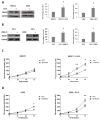TRAF6 Silencing Attenuates Multiple Myeloma Cell Adhesion to Bone Marrow Stromal Cells
- PMID: 30736330
- PMCID: PMC6387103
- DOI: 10.3390/ijms20030702
TRAF6 Silencing Attenuates Multiple Myeloma Cell Adhesion to Bone Marrow Stromal Cells
Abstract
The bone marrow (BM) microenvironment plays an important role in supporting proliferation, survival and drug resistance of Multiple Myeloma (MM) cells. MM cells adhere to bone marrow stromal cells leading to the activation of tumour-promoting signaling pathways. Activation of the NFκB pathway, in particular, is central to the pathogenesis of MM. Tumour necrosis factor receptor-associated factor 6 (TRAF6) is a key mediator of NFκB activation and has previously been highlighted as a potential therapeutic target in MM. Here, we demonstrate that adherence of MM cell lines to stromal cells results in a reciprocal increase in TRAF6 expression. Knockdown of TRAF6 expression attenuates the ability of MM cells to bind to stromal cells and this is associated with a decrease in NFκB-induced expression of the adhesion molecules ICAM1 and VCAM1. Finally, we show that knockdown of TRAF6 sensitizes MM cells to treatment with bortezomib when co-cultured with stromal cells. Inhibiting TRAF6 represents a promising strategy to target MM cells in the BM microenvironment.
Keywords: BMSCs; Multiple Myeloma; TRAF6.
Conflict of interest statement
The authors declare no conflict of interest.
Figures




References
MeSH terms
Substances
LinkOut - more resources
Full Text Sources
Medical
Miscellaneous

